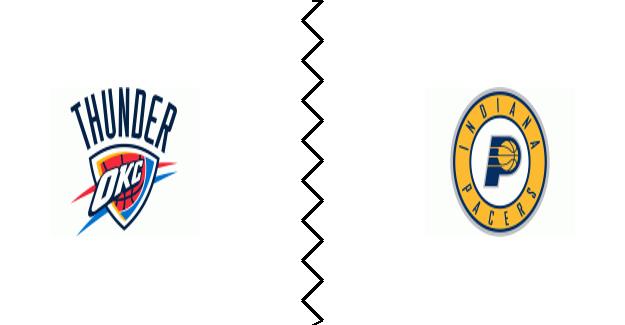2025-06-13 Oklahoma City at Indiana Matchup Preview

Oklahoma City's offensive rebounding prowess and defensive disruption will be tested against Indiana's ball movement and interior defense in what is expected to be a pivotal playoff matchup.


Offensive Overview
Oklahoma City boasts a potent offense predicated on generating second-chance opportunities and limiting turnovers. The Thunder secure offensive rebounds on 24.2% of their missed shots during the regular season, and even elevated that rate to 25.2% in the playoffs, showcasing their commitment to crashing the boards. They also protect the ball well, demonstrated by their low turnover percentage of 10.3% during the regular season. In the playoffs, their turnover percentage has increased slightly to 10.5%, but they are still efficient. Their assist-to-turnover ratio stands at 2.3 during the regular season and 2.0 in the playoffs, demonstrating their ability to make the right plays more often than not. The team's offensive game is built around player movement and exploiting mismatches, often leading to high-percentage looks inside. Their continuity-based approach, centered around primary playmakers, allows them to maintain offensive flow and composure even in high-pressure situations.
Defensive Overview
Oklahoma City's defense is built around disrupting opponents and securing defensive rebounds. The Thunder excel at limiting opponents' passing efficiency, with an opponent assist percentage of 64.9% in the regular season. In the playoffs, that number has tightened to 58.3%, suggesting an increased focus on disrupting passing lanes. Their ability to force turnovers is also noteworthy, as indicated by an opponent turnover percentage of 14.8% during the regular season, which has risen to 15.5% in the playoffs. Oklahoma City excels at both steals and blocks. Their steal percentage of 10.3% and block percentage of 11.9% during the regular season indicate a defense that is actively looking to create turnovers and protect the rim. In the playoffs, their steal percentage has improved to 10.6%, while their block percentage has dipped slightly to 11.2%, but they're still active. Their defensive rebound percentage of 74.7% ensures they control the glass, limiting second-chance opportunities for their opponents. The Thunder's defensive scheme involves a combination of aggressive on-ball defense and help rotations, often forcing opponents into difficult shots and turnovers. They primarily use a man-to-man defense with timely double-teams, seeking to disrupt the opposing team's rhythm.
Indiana's Offensive Approach
Indiana's offense thrives on ball movement and creating open looks for their shooters. They assist on 67.1% of their made field goals during the regular season. In the playoffs, their assist percentage has decreased to 65.5%, indicating a slight reliance on individual playmaking. While their offensive rebounding percentage is lower than Oklahoma City's, sitting at 21.3% during the regular season and 18.7% in the playoffs, they compensate with excellent ball security. Their turnover percentage of 11.8% during the regular season has improved slightly to 12.4% in the playoffs. Indiana's true shooting percentage of 0.61 in the playoffs shows that they have an efficient offense. The Indiana Pacers use a motion offense with a focus on spacing and ball movement, and they also have many series-oriented set plays, which allows them to be versatile and have multiple options to score on any possession.
Indiana's Defensive Strategy
Indiana's defense prioritizes protecting the paint and contesting shots effectively. They have a defensive rebound percentage of 74.5% during the regular season, demonstrating their ability to secure possessions after missed shots. In the playoffs, their defensive rebound percentage has increased slightly to 73.9%. The Pacers also excel at limiting opponent assists, with an opponent assist percentage of 61.0% during the regular season. In the playoffs, this number has dropped to 52.3%, suggesting a more effective scheme in preventing ball movement. Their opponent turnover percentage of 13.2% during the regular season indicates a solid ability to force mistakes, while in the playoffs it has decreased slightly to 12.4%. The Indiana Pacers' block percentage is 10.2% in the regular season and 11.4% in the playoffs. The Pacers often employ a pack-line defense designed to limit penetration and force opponents to take contested jump shots. They emphasize help rotations and rim protection.
Key Matchup Factors
Oklahoma City's ability to generate second-chance points through offensive rebounds will be crucial against Indiana's defensive rebounding strength. The Thunder's offensive rebounding percentage of 25.2% is a strength that will be tested by Indiana's defensive rebounding percentage of 73.9% in the playoffs. Conversely, Indiana's ball movement will test Oklahoma City's ability to disrupt passing lanes. Oklahoma City's defense excels at limiting opponent assists, with a 58.3% opponent assist percentage in the playoffs, and Indiana's passing success will depend on their ability to overcome this defensive pressure. Oklahoma City also seems to do a good job at limiting opponents from shooting the three, as it is at 33.9%. Their ability to do this may play a huge factor in the game.
Game Prediction
Given Oklahoma City's advantages in offensive rebounding and defensive disruption, combined with their slightly faster pace, they are favored to win this matchup. Their ability to control the glass and force turnovers will likely disrupt Indiana's offensive flow and prevent them from getting into a rhythm. Oklahoma City's balanced attack will prove difficult for Indiana to contain, leading to a higher scoring output for the Thunder. The Thunder are also more efficient at limiting three point attempts, and the Pacers like to shoot from three.
Predicted Score: Oklahoma City 118, Indiana 104